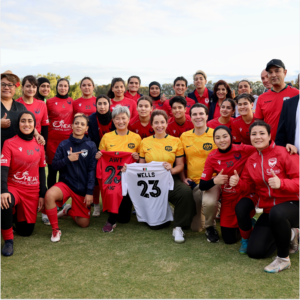17-year-old Sama of the Afghanistan Newsroom explains the barriers preventing Afghan girls from getting involved in sport

Afghanistan women’s national football team in Australia, 2023.
Picture by: Sarah Friend | DFAT
Article link copied.
March 28, 2025
Afghan women fight for sport amid digital distractions
For Afghan women, sport has long provided a rare opportunity to break free from societal constraints. Amid traditional pressures and limited freedoms, participating in sport promotes physical health and offers self-expression and empowerment. However, two significant challenges – societal restrictions and digital distractions – threaten to limit their participation.
Harbingers’ Weekly Brief
In the early 2000s, Afghan women and girls began to set up the country’s first football teams, defying societal norms. One of the key figures in this movement was Khalida Popal, who, in 2007, with the support of the Afghan Football Association, helped establish the Afghan women’s football league. Popal and her friends saw football as more than just a game; it was a tool for empowerment, fostering confidence, physical well-being and solidarity.
Shamila Kohestani, the former captain of the Afghan women’s national football team, also fought for the right to play. In an interview with the BBC, Kohestani explained that football was more than a game in Afghanistan – it was an act of defiance against gender norms and a fight for freedom. For Kohestani, sport was a way to challenge entrenched societal expectations and provide women with a platform to be heard.

Khalida Popal, former captain of the Afghan women’s football team.
Picture by: Julie Lunde Lillesæter | PRIO | Flickr
By 2021, the return of the Taliban to power devastated women’s rights, especially in sport. The Taliban banned women from participating in any sport, forcing athletes such as Popal and Kohestani to flee Afghanistan for their safety and careers.
Beyond political oppression, Afghan women face the growing obstacle of digital distractions. The rise of mobile phones and internet access has led to widespread use of social media and online entertainment, capturing the attention of younger generations. For women like Zuhal*, 23, from Herat, these digital spaces have replaced sport as a primary form of engagement.
Afghanistan has 3.7 million social media users, 8.6% of the population, according to data from January 2024. Facebook seems to be the most popular platform, but X (formerly Twitter), Instagram and YouTube are also used.
“Growing up, I loved playing football with my friends. Now, I spend hours scrolling through social media or watching videos,” Zuhal shares. “It’s hard to stay motivated to go out and play when there’s so much happening online.”
This shift is contributing to a more sedentary lifestyle, with physical activity taking a backseat to screen-based entertainment. Instead of bonding over sports, young women bond over posts and likes, negatively impacting both their physical and mental health.
The consequences of limiting sports participation are far-reaching. Physically, inactivity leads to higher risks of muscle weakness, obesity and heart disease. Mentally, the absence of sport as an emotional outlet increases stress, anxiety and depression, leaving many women feeling isolated.
The exile of pioneering female football players such as Popal and Kohestani left a significant gap in role models, leaving young girls with fewer examples to follow, further reinforcing the belief that athletic success is out of reach for Afghan women.
Despite these challenges, there is hope. Awareness campaigns, educational programmes and media efforts can help shift attitudes towards sport for women. Creating safe, women-only spaces for physical activities and promoting female athletes to young people through digital platforms can help revive the movement.
International organisations, NGOs and local communities can also support women’s sport programmes by providing resources and funding, as with the Afghan women’s cricket team. These initiatives will not only improve physical health, but empower Afghan women to overcome societal barriers and reclaim their space in sport.
Although sport has been silenced for Afghan women, their desire to participate remains strong. With initiatives including safer spaces and digital engagement as well as policy changes, sport can continue to empower Afghan women. The fight for sport participation is about challenging societal norms and reclaiming agency.
Afghan women’s resilience proves that the game is far from over.
* Names have been changed to protect identities
Written by:

Afghanistan
Contributor
LEARN Journalism Club
Illustration by Yuliia Muliar
Born in 2007, Sama is currently studying journalism through the joint project between Harbingers’ Magazine and LEARN Afghan.
Sama is interested in science and journalism, and enjoys sharing her knowledge with Harbingers’ audience. She dreams of one day being a businesswoman or a doctor, and wants to motivate other girls towards their dreams.
Sama speaks Dari and English.
Due to security concerns the author’s image and surname have been omitted
Edited by:

🌍 Join the World's Youngest Newsroom—Create a Free Account
Sign up to save your favourite articles, get personalised recommendations, and stay informed about stories that Gen Z worldwide actually care about. Plus, subscribe to our newsletter for the latest stories delivered straight to your inbox. 📲
© 2025 The Oxford School for the Future of Journalism


